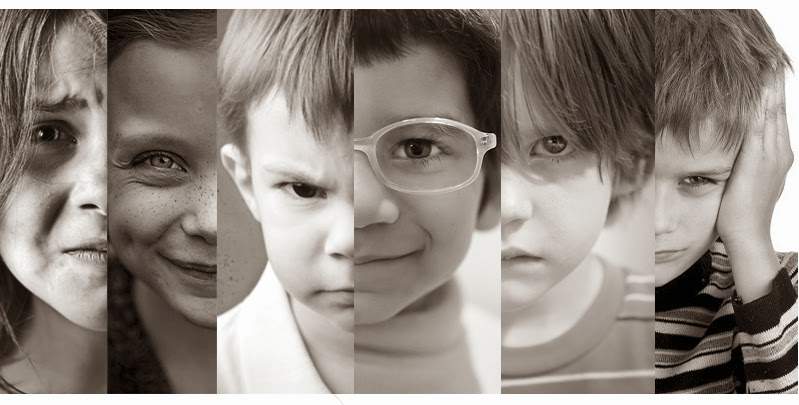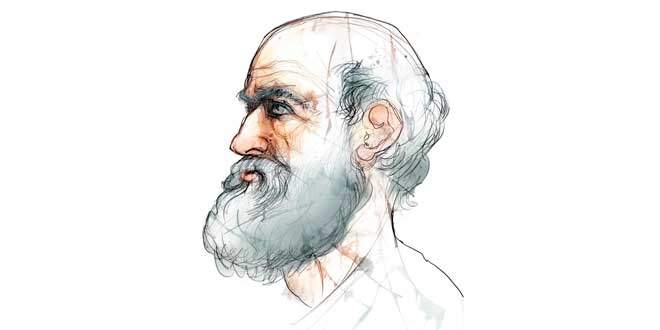Infant temperament and adjustment goodness. Adapt to your child

- 3257
- 741
- Austin Stokes
My purpose with this article is to clarify the concept of temperament, tell its history, through authors such as Hippocrates or Ivan Pavlov and the main dominant theories today. From there, we will draw the differences between, those that Thomas and Chess called, easy children, difficult children and slow reaction children.
From the Thomas and Chess Theory, We will stand in the concept of adjustment goodness, created and coined by them, which is not talked about much and has a vital importance for the treatment of parents with their children. We will develop the main theoretical ideas regarding the concept, and then give some tips or initiatives to take into account for the care of the little ones.
Content
Toggle- History of temperament
- Hippocrates
- Ivan Pavlov
- Thomas and Chess
- Easy children
- Difficult children
- Slow reaction children
- Buss and plmen
- Emotionality
- Activity
- Sociability
- Adjustment goodness
- Temperament and attachment
- Bibliographic references
History of temperament
The term temperament refers to the fact that every individual manifests a peculiar style of behavioral functioning, of emotional nature and linked to his personality, a concept that was appointed from the ancient age, in Greek medicine, in philosophy, and is still in force. The word temperament comes from the Latin temperamentum (mixture).

Usually Personality will be the final product formed by the interaction of individual temperament with the environment. We refer to the term temperament to the characteristics that They are present at the time of birth, and that are relatively stable During childhood (Stifer and Jain, 1996).
The definition of temperament, with which we are going to stay here, is that of Allport (1975)
Temperament refers to the characteristic phenomena of the nature of the individual, including its susceptibility to emotional stimulation, its usual energy and its speed of response, the quality of its prevalent mood and all the peculiarities of fluctuation and intensity of mood , being considered these phenomena as dependent on the constitutional set and therefore, of hereditary origin.
Hippocrates
Hippocrates in the 5th century.C. He described four types or categories of individuals, whom he called moods (López, 2016):
- The blood or cheerful: It is cheerful, energetic, vigorous, with power. They are people in a good mood, passionate and who provide trust.
- The melancholic or black bile: The melancholic is restless, very reflective, unstable and anxious. They worship silence and loneliness, forget about their surroundings and easily distracted.
- The choleric, related to an increase in yellow bile: The choleric is persevering, fast in its decisions, which aspires big, active and extrovert. They are ambitious, individualistic and demanding people.
- The phlegmatic, to which an excess of phlegm is attributed: The phlegmatic man is reflective, calm, very fair and incorruptible, little committed, nice. They love good life and they like work little. Typical of passive or calm individuals

The Greeks and the Romans, in the 5th century.C., They believed that the relationship between the four moods created an opposition to two universal complementary qualities: Heat vs coldness, and dryness vs moisture (Siegel, 1968, as cited in Tieñol et al., 2003). These qualities were related to the four fundamental elements of the world: Water, air, fire and earth. The Greeks assumed that the balance between these qualities produced an internal harmonious state that included the rationality, emotionality and behavior. Children were impulsive and irrational because they were born with a excess moisture.
Ivan Pavlov
Ivan Pavlov, the concept of temperament approached and resumed. He tried with dogs the conditioning. Some dogs learned well, and they stayed with the same behavior (Molina and Batlle, S.F.). Others got angry and threw like possess. Some lay down and some jumped and twisted.
Pavlov deduced that he could explain these personality types through two dimensions:
- Global stimulation level (called excitement) that dog brains had available.
- The ability of these brains to change their stimulation levels: the level of inhibition that their brains had available.

And, this, he wanted to relate again to use the concepts of the Greeks of the temperament commented in the previous section, then explained in the following ways (Molina and Batlle, S.F.):
- A lot of stimulation and good inhibition: Blood.
- Much stimulation and poor inhibition: choleric.
- Not much stimulation and considerable inhibition: phlegmatic.
- Not much stimulation and poor inhibition: melancholic.
At present, the most accepted models and theories about temperament are the two that we present below, above all the theory of Thomas and Chess.
The 4 types of human temperament
Thomas and Chess
These authors did different longitudinal studies, since the decade of the 50 to the 80s (Molina and Batlle, S.F.). The Longitudinal studies These are studies in which a monitoring, every x years, is followed up, to see the changes that arise in the development of the sample. Of these studies they took different hypotheses:
- He Temperament is a set of behavior patterns, which have a biological base, although they can be modified and influenced.
- The Children, from birth, have marked individual differences In your behavior patterns.
- Temperament and environment are related bidirectionally and are interdependent.
- He temperament is not the same as personality.
- The concept of adjustment goodness, What will you see later.
In 1968, Alexander Thomas and Stella Chess revolutionized approaches to the child's temperament and highlighted their ability to influence the environment. They contrasted this perspective with models that traditionally considered the child as a passive receptor of external influences, or of a unilineal and unidirectional causal models (Estañol et al., 2003). Thomas and Chess established nine categories of temperament:
- Activity level: The motor component in the functioning of a child, related to daytime activities and inactive periods. Child's physical activity.
- Rhythmic regularity: The predictability of any function or behavior of the child. It can be seen in relation to the sleep and vigil cycle, hunger, feeding pattern or defecation. Regularity in their routines and activities.
- Approach or isolation: The initial reaction to any new stimulus, be it a food, a toy, or a person. Approach responses are positive, and isolation reactions are negative.
- Adaptability: responses to new or altered situations. The initial responses are not a cause for concern, but the ease with which they are redirected or modified towards a desired direction.
- Response threshold: the level of intensity of the stimulation necessary to evoke an answer. Used behaviors are those concerning reactions to sensory stimuli, environmental objects and social contacts.
- Reaction intensity: The energy level of the response, regardless of its quality or address.
- Humor quality: The amount of pleasant, happy and friendly affection, in contrast to the dislacant, little friendly or uncomfortable behavior.
- Distractability: The effectiveness of strange environmental stimuli, which interfere or alter the direction of the behavior initiated. Ability to get distracted or not do so.
- Persistence and attention capacity: The attention capacity refers to the amount of time in which a particular activity is maintained or followed by the child, especially persistence in difficult situations is valued.

Based on these nine aspects, they drawn the differences between the different children. The authors found, through the clinic as through factor analysis, Three types of temperaments o Diagnostic categories: easy temperament (easy children), difficult temperament (difficult children) and slow reactions (slow reaction children).
-
Easy children
These children are shown regular In food, sleep and elimination cycles. They have one Positive reaction towards new situations and can accept frustration. They adapt to changes quickly. Have good humor most of the time and smile enough. Easy children have a Positive humor are happy and affectionate.
-
Difficult children
These children, unlike the previous ones, are irregular In food, elimination and sleep, in addition to having negative responses Like crying or tantrums in new situations and frustrations. They have trouble adapting To the change. They have socialization problems, with family, school and with their classmates. They usually have a Negative humor and high irritability.
-
Slow reaction children
Slow reaction children are not very active and not accessible, that is, shy and fearful children. These children show negative responses, but of less intensity than difficult children, when they are in new situations, but they are gradually accepting them. They have quite regular routines. His biggest problems vary from one child to another.
Buss and plmen
The theory of Bluss and Plomin considers temperament as a set of Personality traits that meet three criteria: they are Inherited, they appear soon in life and show stability Throughout the life cycle (Vives and Batlle, S.F.). The temperaments that meet the triple criteria are: Emotionality, activity and sociability (EAS).
Each of the temperaments is related to the evolutionary inheritance and personality development, and have been observed in a wide variety of species. The theory initially included the impulsiveness, although it was excluded by the lack of sufficient evidence with respect to the inheritability of said trait.
-
Emotionality
Emotionality is described as a Status of discomfort that is accompanied by a high level of arousal. During the first six months of life, this emotion of discomfort is differentiating in fear and anger. He fear and anger They are considered by the majority of authors as universal emotions and is expressed through motor, expressive, physiological and cognitive processes, whose variation gives rise to individual differences.
Children can differentiate both in the Activation threshold (Minimum stimulus intensity to cause the fear or anger response), latency time (time between the stimulus and the answer) and the response duration. In this sense, the most fearful or irascible children present a lower threshold, a lower latency time and a longer response duration.
-
Activity
The activity is a temperament feature that refers to the way in which the answers are made, and not to its content. The activity is defined as the Physical Energy Expenditure, and it is observed through its components of: time, vigor and resistance. The activity refers only to head, trunk and limb movements.
He time refers to the speed with which the actions are carried out. In this sense we have fast and slow children. He vigor mentions the amplitude or intensity of the actions. Very active children use more strength in their actions, squeak harder and hit the objects more frequently than less active children who would open the door more softly and raise the tone of voice little. In third place we have the endurance which refers to the time of permanence in the same activity. In this sense, children with high resistance tend to be active throughout the day than those who have low resistance.
-
Sociability
Sociability is defined as the child preference for being with others instead of staying alone. Very sociable children are strongly motivated by the search for company and do not tolerate being alone, needing continuous attention to be paid. On the contrary, the least sociable tolerate loneliness better and seek less attention to others, which by excess can consider intrusive, although as a social species, they do not intend the isolation.

Adjustment goodness
The adjustment of a person to their context is the result of the interaction of organismic and environmental variables, which means the basis of many theoretical perspectives in psychology (Lozano et al., 2007). The concept of Thomas and Chess adjustment goodness, Formulated in 1977, it provides a useful framework to understand the mechanisms by which certain personal characteristics, temperament, in their interaction with environmental factors, can lead to different forms of social functioning, and more specifically of the child.
Adjustment goodness occurs when the temperament of a child and other characteristics, such as intellectual level, and own skills, are suitable for dealing with the demands, expectations and opportunities of the environment, which leads to optimal development for him. In the case in which the child cannot successfully face the challenges of his surroundings, what is called adjustment poverty is produced. This leads to the subject to a maladaptive functioning and a distorted development.
Papalia (2010) defined adjustment goodness as "Adaptation of a child's temperament to environmental demands and restrictions". You have to keep in mind that The child's temperament is innate, It is not learned by reinforcements as other disciplines can say, but it has been shown to be an innate and hardly moldable in childhood, being greater the plasticity of temperament after childhood.
"The key to achieving a healthy adaptation is the goodness of adjustment, the correspondence between the child's temperament and the demands and restrictions of the environment of which the child must take care "(Papalia, 2010, P183). Problems may arise if a very active child is expected to remain motionless, if a slow one to be encouraged to constantly pushes new situations, or if one persistent is moved away from intriguing projects (Belsky, 1997, 2005; Stright, Gallagher and Kelley, 2008, as cited in Papalia, 2010).
Children with difficult temperament can be more vulnerable to the quality of parenting than other children with easy or slow reaction, and may need More emotional support and respect for their autonomy. Parents who recognize that a child acts in a certain way due to innate trends and not for laziness or stupidity are less likely to feel guilt, anxiety and hostility. They can also anticipate the child's reactions and help him adapt.
The theorists of development, evolutionary psychology and psychology of the life cycle have stated that The good parents They can react differently because they are sensitive and flexible with respect to the individuality of each child, instead that children adapt to the same mold or reaction (Martínez et al., 2014). That is to say, that parents adjust and adapt to children instead of the other way around, to achieve the child's optimal development.
After all these data, following Papalia's ideas, we can deduce that the best It is not that there are easy children or difficult children, but there are parents who adapt well to the needs of their children and parents who adapt in a less optimal way. Ensuring good adjustment means that the adult must create a family climate that recognize the child's temperamental style and foster its adaptation (Martín et al., 2009).
 Brain, motor and perceptual development in childhood
Brain, motor and perceptual development in childhood Temperament and attachment
In an investigation with children from 6 to 12 months and their families, it was observed that Lto the mother's sensitivity and the temperament of her child influenced the attachment patterns (Seifer et al., 1996, as cited in Papalia, 2010). Some neurological or physiological aspects can influence temperamental differences in attachment .
"The temperament of a baby can not only have a direct effect on attachment but also an indirect one through its effect on parents"(Papalia, 2010, P. 190). In studies in the Netherlands, 15 -day age -classy babies classified as irritable were much more likely than not irritable to show an insecure attachment (especially avoidance attachment). On the contrary, irritable babies whose caregivers received visits at home where they were taught to calm down were as probability as not irritable to be qualified as children with safe attachment.
Therefore, the irritability of an infant can prevent the development of a safe attach., 2000, as cited in Papalia, 2010). The goodness of adjustment between father and son may well be the key to understanding the security of attachment.
Test camir-r to evaluate your attachment link, discover which is yours
Bibliographic references
- Albores-Gallo, l., Márquez-Caraveo, m. AND., & Estañol, B. (2003). What is temperament? The return of an ancestral concept. Mental health, 26(3), 16-26. https: // www.Medigraphic.com/pdfs/salmen/Sam-2003/Sam033c.PDF
- Allport, g. W. (1975). Personality Development. The Learner, The Learning Process, The School, 66(3), 10.
- Aguirre Acevedo, D. C., Cristina Garcia, M., & Martínez, M. (2015). Response to stress, temperament and upbringing in Colombian children of 1 year. https: // hdl.Handle.Net/10495/32359
- Farkas, c. & Rodríguez, K. TO. (2017). Maternal perception of child socio -emotional development: relationship with child temperament and maternal sensitivity. Psychological Research Act, 7(2), 2735-2746. https: // doi.org/10.1016/J.aipprr.2017.06.003
- Feldman, r. D., Gross, d., Olds, s. W., Salinas, m. AND. EITHER., & Papalia, D. AND. (2005). Human development. https: // psychologoseducativas generation20172021.Files.WordPress.com/2017/08/Papalia-Feldman-Development-Human-12A-Ed2.PDF
- López Huertas, N. (10/17/2016). Gomeres: Health, History, Culture and Thought.
- Lozano, e. TO., Conesa, m. D. G., & Hernández, E. H. (2007). Relationships between educational styles, temperament and social adjustment in childhood: a review. Annals of Psychology Annals/Annals, 23(1), 33-40. https: // magazines.um.ES/ANALESPS/ARTICLE/VIEW/23231
- Ramos Martín, J. M., Sancho García, M., CACHER SANZ, P., Vara Arias, M., & Iturria Matamala, B. (2009). The child temperament in the field of primary prevention: relationship with the development quotient and its modifiability. Clinic and health, twenty(1), 67-78. https: // scielo.ISCIII.ES/PDF/CLINSA/V20N1/V20N1A06.PDF
- Rothbart, m. (2011). Early temperament and psychosocial development. Temper. Encyclopedia on early childhood development; Rothbart, mk, ed.
- « Staging technique in therapy, what is and how is used
- The approach, a refraint technique in family therapy »

